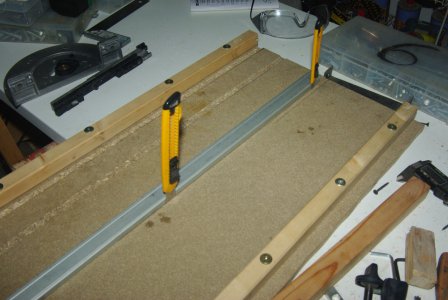- Joined
- Dec 17, 2012
- Messages
- 745
If you make a straight cut or a dado into whatever material, then you have to trace a line on the prosecution of that cut, here is a trick I discovered some days ago (I'm sure I'm not the first one to get it…)

Insert a couple of snap-off knives (Stanley, X-Acto, cutter, drywall knife, cortaplumas or whatever you call the orange knives in the photo) into the cut, push against them a straightedge (or a ruler, a yardstick or even an aluminum profile like that in the photo), and trace the line with a blade having the same thickness of those used as support.
Take care of leaning knifes if you are working with a thin material.
If the cut is made with a thick blade I suggest to trace on both sides of it: just put the ruler on the other side.
This method is not absolutely precise, but it is better (and a lot faster!) than eyeballing the cut. It works even if you have to join two short cuts on both ends of a board.
I leave to the readers the duty of thinking how to make a gig with small scraps of wood and old blades


Insert a couple of snap-off knives (Stanley, X-Acto, cutter, drywall knife, cortaplumas or whatever you call the orange knives in the photo) into the cut, push against them a straightedge (or a ruler, a yardstick or even an aluminum profile like that in the photo), and trace the line with a blade having the same thickness of those used as support.
Take care of leaning knifes if you are working with a thin material.
If the cut is made with a thick blade I suggest to trace on both sides of it: just put the ruler on the other side.
This method is not absolutely precise, but it is better (and a lot faster!) than eyeballing the cut. It works even if you have to join two short cuts on both ends of a board.
I leave to the readers the duty of thinking how to make a gig with small scraps of wood and old blades

